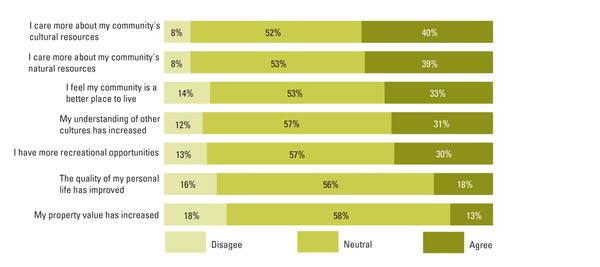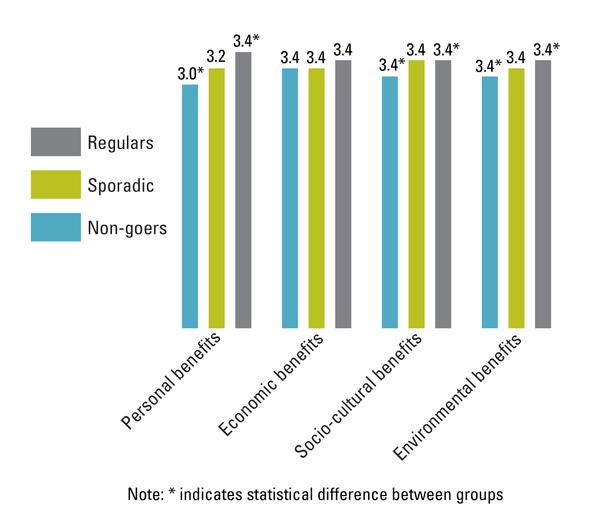Wine Tourism and Community Development
Wine tourism is the visitation to vineyards, wineries, and wine-related events for wine tasting or to experience the attributes of a wine region. This form of tourism has grown considerably in the last decade worldwide, including in North Carolina, mainly because wine tourism can foster regional development. The increase of North Carolina wine production, for example, has contributed to diversify the economy, generate jobs, and create new market opportunities in rural communities (Ferreira, 2012). However, both building and sustaining successful wine tourism destinations require strong support from local residents (Canziani & Byrd, 2014).
Despite the growth of North Carolina wine tourism and its contribution to local development, it is still unknown whether North Carolinians perceive any benefit from the spur of wineries in their communities. Because that information is critical to optimize the benefits of wine tourism, we surveyed residents of the North Carolina Piedmont Triad to learn how they perceive the contributions of their surrounding wineries. We chose the Triad as the study setting because it is where the first American Viticulture Area of the state was recognized by the US government and because the Triad houses most of North Carolina wineries (NC Department of Agriculture & Consumer Services, 2015).
About This Study and Its Participants
In 2013 we randomly distributed a survey to 663 households located within 10 miles of the Haw River and Surry County wine trails of the Triad. The household sample was stratified to include all zip codes within the study area and to capture households located with varying distances from the wine trails. The survey was hand-delivered to randomly selected households and collected two to three days afterward; participants could also mail back the survey.
The survey asked neighbors about a wide range of sociocultural, environmental, and economic benefits that respondents feel local wineries deliver to their communities and their families; respondents’ level of participation in various wine-related activities (such as visits to wineries and wine club memberships); and household demographic information. Statistical analyses conducted for this report include descriptives, chi-square tests, Cronbach’s reliability tests, and MANOVA (significant at p < 0.05).
A total of 344 households completed the survey (52% response rate). Our typical respondent was female (58%), middle-aged (average of 52 years old), and had at least a two-year college degree (47%). Half (49%) reported a pre-tax household income of up to $50,000, and 29% earned at least $75,000. Almost one-third (32%) were retirees.
Three Types of Winery Visitors in the Triad
Overall, Triad neighbors are not very engaged with wine-related activities. Most have not visited a winery in the Triad (52%) or outside the Triad (71%) in the last three years. Likewise, the vast majority of respondents (90%) are not involved with any wine-related activity; very few follow online wine-related social media (5%), are members of a wine club (5%), participate in informal wine social groups (4%), or subscribe to wine-related magazines (2%).
We classified Triad neighbors into three groups based on how frequently they visited local wineries in the last three years: Non-goers (52%), Sporadic (17%), and Regulars (31%). These groups have similar demographic characteristics.
|
Three Types of Triad Winery Visitors In the last three years: Non-goers: Did not visit a Triad winery (52%). Sporadic: Visited a Triad winery but rarely (17%). Regulars: Visited a Triad winery at least occasionally (31%). |
Neighbors Perceive Some Benefits from Triad Wineries
Triad neighbors of wineries believe that local wineries contribute somewhat to their community’s well-being and their personal lives. At the community level, respondents recognize that wineries have enhanced some economic, sociocultural, and environmental aspects of their communities (Table 1). The greater contributions respondents perceive are economic. Most perceive that Triad wineries have increased tourists’ spending (68%) and the variety of local businesses (57%). About half also believe that local wineries have revitalized their local economies in terms of increased number of jobs (48%) and businesses (46%).
Worth noting, most respondents recognize an increase in the variety of cultural activities (54%) and the landscape beautification (53%) in their communities as a result of Triad wine tourism development. Some negative impacts generally associated with rapid tourism development are not prominent in the Triad either. Only a handful of respondents feel that crime (9%), littering (8%), traffic congestion (14%), and overcrowding of public areas (14%) have increased in their community due to wine tourism development.
Triad neighbors recognize the contributions of local wineries on their personal lives to a lesser extent (Figure 1). Many respondents feel they care more about the cultural (40%) and natural (39%) resources of their communities because of Triad wine tourism development. One-third of respondents also believe their community is a better place to live (33%) and that their understanding of other cultures has increased (31%).
| Economic Benefits | |||
| Decreased | Stayed the Same | Increased | |
| Tourists' spending | 3% | 29% | 68% |
| Variety of local businesses | 3% | 40% | 57% |
| Number of local businesses | 4% | 49% | 46% |
| Number of jobs | 6% | 46% | 48% |
| Community economic stability | 6% | 70% | 24% |
| Economic inequality among residents | 6% | 80% | 13% |
| Prices of goods and services | 4% | 72% | 24% |
| Real estate & property tax | 3% | 66% | 30% |
| Sociocultural Benefits | |||
| Decreased | Stayed the Same | Increased | |
| Variety of cultural activities | 4% | 42% | 54% |
| Conservation of local heritage | 3% | 64% | 33% |
| Sense of community identity | 4% | 66% | 30% |
| Residents' quality of life | 4% | 68% | 28% |
| Number of recreational facilities | 3% | 75% | 22% |
| Communities' small-town feeling | 8% | 68% | 24% |
| Quality of public services | 4% | 84% | 13% |
| Crime in the community | 7% | 84% | 9% |
| Environmental Benefits | |||
| Decreased | Stayed the Same | Increased | |
| Beauty of local landscapes | 3% | 44% | 53% |
| Environmental consciousness | 3% | 68% | 29% |
| Health of local ecosystems | 4% | 68% | 28% |
| Tranquility of community | 7% | 68% | 25% |
| Quality of public infrastructure | 2% | 81% | 17% |
| Littering | 11% | 81% | 8% |
| Traffic congestion | 5% | 81% | 14% |
More Visits, Better Perception
Overall, the more frequently respondents visit Triad wineries, the more they recognize the contributions of local wineries (Figure 2). Regulars are overall the most aware, while Non-goers are the least aware of the winery benefits. More specifically, Regulars are more cognizant than Non-goers of the personal, socio-cultural, and environmental benefits wineries produce. However, the three types of winery visitors have similar awareness of the economic contributions made by local wineries.
Final Remarks and Study Take-Aways
From this study, we can highlight three major findings related to wine tourism development. First, neighbors of Triad wineries are somewhat aware of the benefits their surrounding wineries bring to their lives and communities, suggesting room for improvement. Second, sociocultural benefits are the most positively perceived, indicating that neighbors place a high value on heritage and traditional lifestyles. And third, visitation to local wineries increases neighbors’ awareness of the contributions made by wine tourism. From these findings we can draw two important lessons to strengthen wine tourism development in the Triad.
|
Considerations for Triad Wineries The Task: Encourage Triad neighbors to visit their wineries more frequently aiming to convert:
The Importance: Local community support is one key to sustaining wine tourism development in the Triad. The Target: Neighbors, irrespective of their demographic characteristics The Strategy: Using a variety of tactics, such as:
|
- Wineries need to reach out to their neighbors.
Winery managers should encourage their neighbors to visit their premises regularly as visiting improves their appreciation for wine tourism. Winery managers can share with visitors different ways to incorporate wine in their daily lives (for example, cooking with wine and considering wine in fund-raising activities for local charities and civic organizations). Given that Regulars were the most cognizant of the respondents about the benefits wineries produce, we suggest managers consider increasing the visitation of Sporadic visitors, as they are already familiar with their wineries. Given that study participants shared similar demographic characteristics across all groups, managers can target the vast pool of neighbors to increase visitation. Wineries can program a variety of wine and nonwine-related public events (such as fairs and festivals) to target neighbors, especially those focusing on traditional and historical themes, as respondents highly valued cultural resources. Wineries may also consider offering special rates and discounts to their surrounding residents to increase interest and visitation, which can increase residents’ support for local wine tourism growth. - Wineries need to educate their neighbors about the benefits wineries produce.
Winery managers should consider investing more effort into communicating to the public, and especially to Triad neighbors, about the range of benefits wineries produce. Managers can do this through a variety of channels—ranging from flyers and radio and newspaper ads to the numerous social media outlets (including Facebook, Twitter, Pinterest, Instagram). Winery mangers should also consider having an updated email list and other social media lists from their customers. To better reach neighbors, we suggest that managers draft messages focusing on the benefits neighbors already recognize (such as increase in tourists’ spending, variety of cultural activities, beautification of local landscapes). By continuing their efforts to increase the awareness of winery-derived community development, winery managers can also increase neighbors’ support for the local wine industry.
In sum, encouraging Triad neighbors to visit their local wineries and increasing their awareness of the benefits these wineries render to surrounding communities can foster greater active community support for wine tourism development over time. By continuing these efforts, wineries can develop mutually beneficial relationships that support the sustainability of wine tourism in the region. In the pursuit of this effort, it is also important to identify and acknowledge the motivations driving residents to visit their local wineries.
References
Canziani, B. and E. Byrd. (2014). Strategic Plan—North Carolina Wine and Grape Industry (2014 – 2019). Report prepared for the NC Wine and Grape Growers Council, NC Department of Agriculture and Consumer Services. Greensboro (NC): University of North Carolina [accessed 2015 Sept].
Ferreira G. (2012). A comparative analysis between Virginia's and North Carolina's wine industries. Blacksburg (VA): Virginia Cooperative Extension [accessed 2015 July].
NC Department of Agriculture & Consumer Services. (2015). North Carolina wineries. Raleigh (NC): NCDA&CS [accessed 2015 July].
Acknowledgment
Our thanks to the following reviewers of this publication: Dr. Erick Byrd (Associate Professor, University of North Carolina at Greensboro); Martha Glass (Executive Director, National Agritourism Professionals Association); and Karla Ward (Director of Marketing) and Ron Taylor (Owner) from Lu Mil Vineyard.
Publication date: April 15, 2016
AG-818
N.C. Cooperative Extension prohibits discrimination and harassment regardless of age, color, disability, family and marital status, gender identity, national origin, political beliefs, race, religion, sex (including pregnancy), sexual orientation and veteran status.


